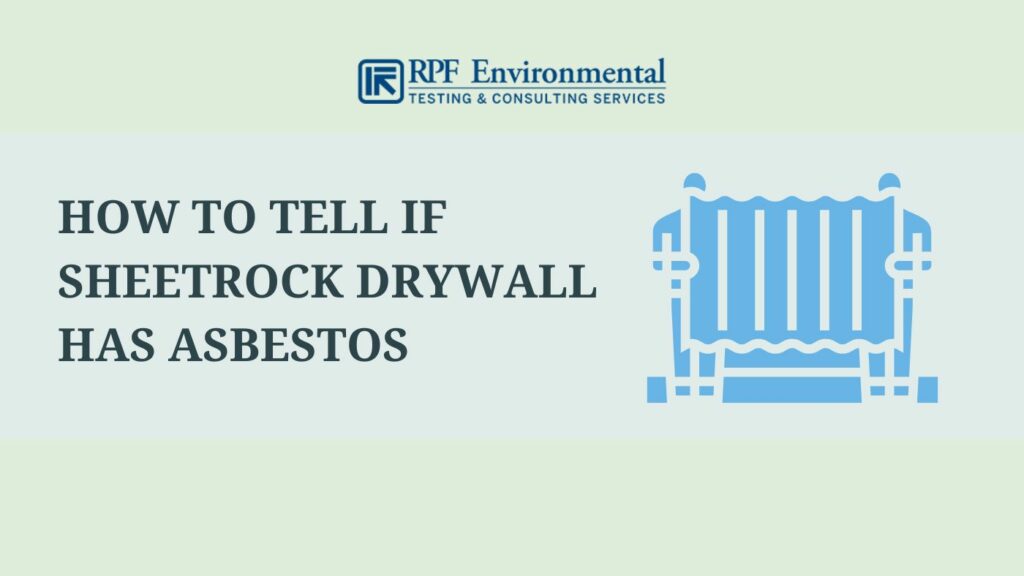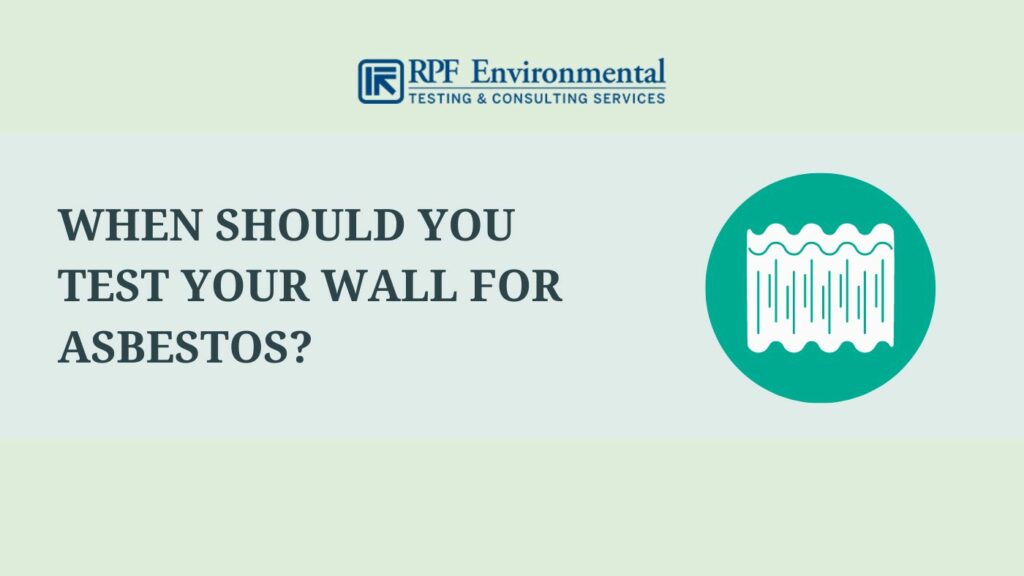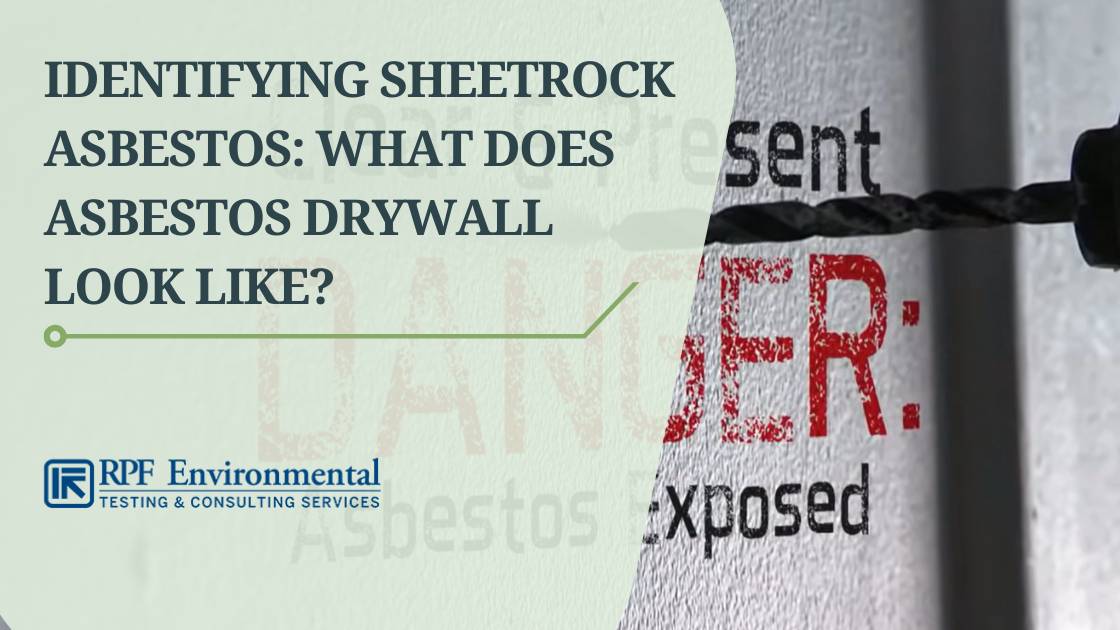Asbestos-based drywall, also referred to as sheetrock or gypsum wallboard, was popularly used in residential, commercial, and industrial structures from the 1930s to the 1980s. Aside from the drywall sheets themselves, tapes and joint compounds also used asbestos additives which can expose building occupants and construction workers once the asbestos fibers become airborne.
Here, you’ll learn more about asbestos sheetrock and asbestos in drywalls, what they look like, tips on identifying them, proper testing and removal, and more.

Hire RPF Environmental for professional sheetrock asbestos testing and inspection services in Illinois, Indiana, Maine, Massachusetts, New Hampshire, and other areas throughout the country. We have certified inspectors to guarantee accurate results and compliance. Contact us now!
What is Sheetrock Asbestos? Why Was It Used?
Sheetrock is a brand owned by the United States Gypsum (U.S. Gypsum or USG now) company. However, it was also widely used to refer to drywall or gypsum wallboard that may have contained asbestos, especially those installed up to the 1980s.
Due to the durability, insulating properties, and fire resistance of asbestos, it was an ideal building material not only for residential and commercial properties but also for industrial factories. It was also widely available and cost-effective. And during the height of asbestos use, drywall was the preferred material for interior walls due to its easy installation and affordability. Thus, asbestos (primarily chrysotile) was used as an additive in drywall products to enhance their durability and make them lighter.
When Was Asbestos Used in Sheetrock Drywall?
Asbestos-containing building materials were manufactured as early as the 1920s up to the 1970s. As for asbestos sheetrock, its use began in the 1930s. This means that almost all new buildings during the time of World War II used asbestos sheetrock or drywall. The demand even became massive after the war.
So if your home was built prior to the 1980s, there is a high chance that it contains asbestos. However, despite the use of asbestos-containing materials (ACM) being regulated by the EPA, buildings constructed from the 1980s up to the 1990s might still contain asbestos.
Where is Asbestos Found in Drywall?
Almost all drywall sheets, joint compounds, surfacing textures, and tapes contain asbestos additives up to the 1970s. Asbestos isn’t usually found in typical sheetrock, but it was common in joint compounds (also called sheetrock mud) which were used in closing off seams between the drywall boards. Aside from drywalls, asbestos-based joint compounds were also used around fixtures, in patches, and as a coating over wall surfaces in buildings. This is why it’s important to sample all layers of your wall for laboratory testing to get accurate results.
How to Tell if Sheetrock Drywall Has Asbestos

Below are the key things you need to know about identifying asbestos sheetrock:
What Does Asbestos in Drywall Look Like?
Asbestos-contaminated drywall sheets often came in 4 x 8 feet standard sizes similar to plywood. The board seams were covered with rolls of paper tape soaked in a gypsum solution followed by a thicker solution to hide imperfections including the tape seams. However, take note that asbestos-based drywall will look similar to modern products so visual inspection won’t be enough. Also, asbestos fibers in drywall can only be viewed using a microscope because they are too small to be seen by the naked eye.
Asbestos-Containing Drywall Manufacturers
Aside from the United States Gypsum company, other manufacturers that produced asbestos-contaminated building materials including drywall were:
- National Gypsum
- Georgia Pacific
- Synkoloid
- Bondex International
- Flintkote
- Hamilton Materials
- Bestwall Gypsum
- Certainteed
- Kaiser Gypsum
- Keene
- W.R. Grace
- Kelly-Moore Paints
You can find specific US Gypsum drywall brands that contain asbestos in the provided link.
Other Signs That Your Home’s Drywall Contains Asbestos
- The building was built or renovated before the 1980s.
- The interior walls are partially constructed using drywall (especially for homes built after the 1930s).
- Old and unlabelled building materials that are starting to wear down
NOTE: EPA states that testing by an accredited asbestos assessment/inspection firm is the only way to know whether drywall or sheet rock contains asbestos.
Drywall Asbestos Risks: How Dangerous Is Exposure to Asbestos in Sheetrock?

Many of the construction workers who have been exposed to toxic airborne fibers through mixing and installing drywall during the boom in asbestos sheetrock have developed deadly asbestos diseases like mesothelioma. Moreover, the installation process can release massive asbestos dust into the air so even homeowners nearby may have been exposed and can develop asbestos diseases.
Today, cutting, sanding, and drilling into asbestos sheetrock during renovation and remodeling activities can cause asbestos fibers to become airborne. The fibers are too small that even a respirator won’t help in preventing exposure. Once inhaled, they collect in your lungs and cause irreversible damage over time which can lead to lung cancer, asbestosis, and other serious conditions aside from mesothelioma.
NOTE: Asbestos diseases can only manifest 10-50 years from exposure often when they have already become untreatable. Have your home or business tested for asbestos to prevent further exposure.
Other Things to Know About Asbestos in Drywall
History of Asbestos Drywall
Lath and plaster was the top choice for finishing interior walls before drywall panels were discovered and replaced it due to easier and faster installation. During the outbreak of World War II, buildings and homes in the U.S. were already using asbestos drywall. After the war, the demand for asbestos drywall skyrocketed.
Is Sheet Rock With Asbestos Still Used Today?
Modern drywall sheets, tapes, and joint compounds are virtually safe to use. However, the use of asbestos in building materials is not yet entirely banned in the U.S. though it is highly regulated by the EPA and OSHA.
Read More: Have New Asbestos Products Really Been Eliminated?
When Should You Test Your Wall for Asbestos?

Below are signs that you should have your home tested for asbestos:
- The building was built and renovated before the 1980s
- If suspected materials are starting to wear down
- Before you do any activity that might disturb ACMs like renovating, remodeling, sanding, painting, etc.
NOTE: Asbestos may also be present in your flooring, insulation, popcorn ceiling, ceiling tiles, piping, and others. Professional asbestos testing and inspection can help accurately identify all types of ACMs in your home/business.
Learn more about how asbestos testing is done here.
Can You Take Samples from Your Drywall Yourself for Testing?
If you know how to properly take samples yourself and where to take them, you can do it on your own. But, make sure that you wear protective equipment and follow safety precautions. The best way to collect a sample is to make sure that you cover all layers of the drywall, especially in the seams where two boards meet.
Professional Asbestos Abatement: What To Do if You Suspect Asbestos Sheetrock In Your Home
Asbestos sheetrock in good condition can be sealed with paint. But if you are going to renovate or remodel your home, completely removing asbestos-contaminated materials in the building by hiring a licensed abatement company is the safest option.
Things to Know About DIY Asbestos Sheetrock Removal
Asbestos drywall is a friable material and can easily release toxic airborne fibers once disturbed, especially if it is starting to deteriorate. Removing them yourself without proper training can release microscopic fibers into the air that can be easily inhaled by anyone nearby. So before you do DIY removal, make sure that:
- DIY asbestos removal is not prohibited in your state
- You follow proper procedures for the safe removal and disposal of asbestos-containing products to avoid liabilities
NOTE: Only do DIY removal in small areas. Leave larger projects to a licensed asbestos abatement professional.
Also Read: Asbestos Plaster Walls: What Does Asbestos Look Like in Walls?
FAQs
Sheetrock is made of gypsum, paper, and various additives. For asbestos sheetrock, asbestos was used as an additive to enhance the drywall’s insulation and fire resistance properties as well as to make it lighter and easier to install.
Sheetrock (used to refer to drywall or gypsum wallboard in general) installed in walls prior to the 1980s is likely to contain asbestos. Modern drywall, tape, and joint compounds are virtually safe to use.
You can’t identify asbestos sheetrock visually because it will look similar to modern alternatives. But among the signs that may indicate that your wall is made of sheetrock asbestos are if the building was built before the 1980s and if the walls are deteriorating. Only professional testing can identify asbestos sheetrock.
Get Your Home/Business Professionally Tested for Asbestos Sheetrock and Other Asbestos Materials
You can’t identify asbestos sheetrock through smell or mere visual inspection. Assume that your home contains asbestos if it was built up to the 1970s. So before you do any activity that might disturb the material and release toxic asbestos fibers into the air, have the building tested by a licensed professional first.
RPF Environmental provides professional asbestos testing and inspection including other environmental testing services for homeowners and business in Maine, Massachusetts, New Hampshire, and beyond. Contact us now and ley our licensed inspectors help you!




